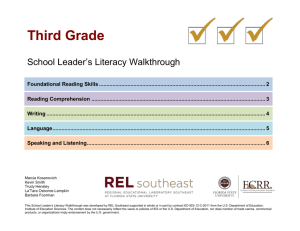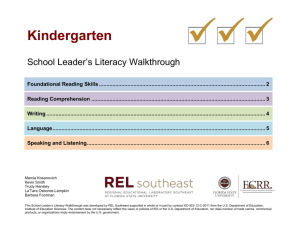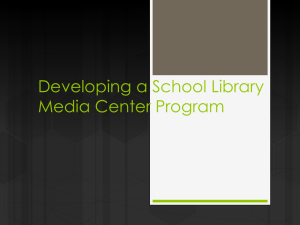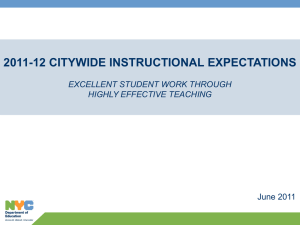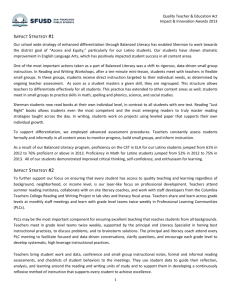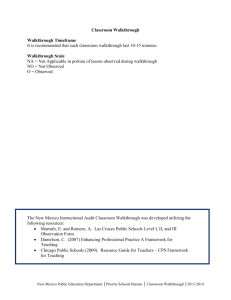the School Leader`s Literacy First Grade Walkthrough
advertisement
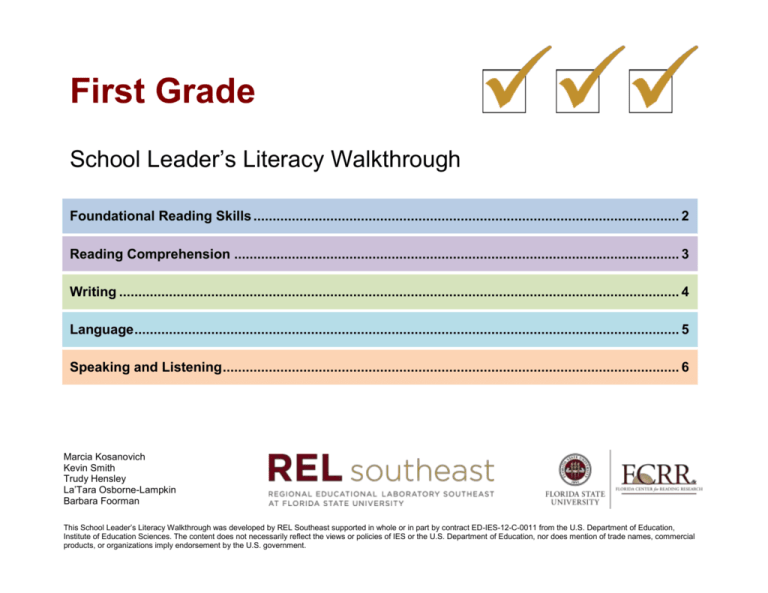
First Grade School Leader’s Literacy Walkthrough Foundational Reading Skills ............................................................................................................... 2 Reading Comprehension .................................................................................................................... 3 Writing .................................................................................................................................................. 4 Language .............................................................................................................................................. 5 Speaking and Listening ....................................................................................................................... 6 Marcia Kosanovich Kevin Smith Trudy Hensley La’Tara Osborne-Lampkin Barbara Foorman This School Leader’s Literacy Walkthrough was developed by REL Southeast supported in whole or in part by contract ED-IES-12-C-0011 from the U.S. Department of Education, Institute of Education Sciences. The content does not necessarily reflect the views or policies of IES or the U.S. Department of Education, nor does mention of trade names, commercial products, or organizations imply endorsement by the U.S. government. First Grade Literacy Walkthrough: Foundational Reading Skills Teacher: Skills/Concepts Print Concepts Date/Time: Evidence Teacher Instruction Student Learning Instructional Materials Teacher Instruction Student Learning Instructional Materials Teacher Instruction Student Learning Instructional Materials Teacher Instruction Student Learning Instructional Materials Identify features of a sentence Phonological Awareness Distinguish long from short vowel sounds in spoken single-syllable words Orally produce single-syllable words by blending individual sounds (e.g., /s/ /i/ /t/, sit) Segment spoken single-syllable words into their sequence of individual sounds (e.g., mat, /m/ /a/ /t/) Phonics and Word Recognition Use a decoding strategy for reading regular one-syllable words that includes segmenting and blending all letters and spelling patterns Read common irregular words (e.g., there, because) Apply letter-sound knowledge in reading and writing activities Use spelling-sound correspondences for common consonant digraphs (e.g., ch-, th-, sh-) Use the final –e rule to represent long vowel sounds to read and write words Use common vowel team conventions (e.g., ea, oa, ee) for long vowels Determine the number of syllables in a printed word by knowing that every syllable must have a vowel sound Use syllable types to break words into syllables in order to decode two-syllable words Read words with inflectional endings (e.g., -est, -ed, -ing) Recognize and read grade-appropriate irregularly spelled words (e.g., would, once, talked) Use manipulatives to practice the connection between phonemes and graphemes Fluency Listen to the teacher read with speed, accuracy, and prosody Read grade level texts with purpose and understanding Read grade-level text orally with accuracy, appropriate rate, and expression on successive readings Reread and use context to confirm or self-correct word recognition and understanding Classroom Environment Evidence Literacy rich environment Classroom arrangement Classroom management 2 First Grade Literacy Walkthrough: Reading Comprehension Teacher: Skills/Concepts Literature and Informational Text Identify the main topic and retell key details Describe the connection between two individuals, events, ideas, or pieces of information Identify reasons an author gives to support points Distinguish between books that tell stories and books that provide information Literary Texts Identify words and phrases that suggest feelings or appeal to the senses Retell a story using details and its message/main idea Use illustrations and key details to describe characters, settings, and major events in a story Identify who is telling a story at different points in the text Compare and contrast the adventures and experiences of characters in stories Ask and answer questions about key details in a text Informational Text Ask and answer questions about key details and to determine the meaning of words and phrases in a text Identify the main idea and retell key details of a text Describe the connection between two individuals, events, ideas, or pieces of information in a text Use text features to locate information in a text Use pictures or other illustrations and words in the text to describe its key ideas Identify the reasons an author gives to support points in a text Compare and contrast two texts on the same topic Identify basic similarities and differences between two informational texts on the same topic (e.g., illustrations, descriptions, or procedures) Recognize different types of informational text structures Date/Time: Evidence Teacher Instruction Student Learning Instructional Materials Teacher Instruction Student Learning Instructional Materials Teacher Instruction Student Learning Instructional Materials Classroom Environment Evidence Literacy rich environment Classroom arrangement Classroom management 3 First Grade Literacy Walkthrough: Writing Teacher: Skills/Concepts Mechanics Print all upper- and lowercase letters Capitalize dates and names of people and punctuate the end of sentences Use a comma in dates and to separate single words in a series Use conventional spelling for words with common spelling patterns and for frequently occurring irregular words Process Write opinions: introduce a topic/name of a book, state an opinion, a reason for that opinion, and provide closure/ending Write to inform/explain: name a topic, offer facts about the topic, and provide closure/ending Write narratives: provide an introduction, appropriately sequence events using details and temporal words (e.g., first, next, last), and provide closure/ending Focus writing on a topic and respond to questions and add details to writing Use a variety of digital tools to produce and publish writing Participate in shared research and writing projects Date/Time: Evidence Teacher Instruction Student Learning Instructional Materials Teacher Instruction Student Learning Instructional Materials Classroom Environment Evidence Literacy rich environment Classroom arrangement Classroom management 4 First Grade Literacy Walkthrough: Language Teacher: Skills/Concepts Conventions of Standard English Use common, proper, and possessive nouns Use singular and plural nouns with matching verbs (e.g., she/plays; we/play) Use verbs to convey past, present, and future (e.g., Yesterday I played. Today I play. Tomorrow I will play.) Use frequently occurring adjectives Use personal, possessive, and indefinite pronouns (e.g., I, me, my; they, them, their) Use frequently occurring conjunctions (e.g., or, so, because) Use frequently occurring prepositions (e.g., before, on, behind) Vocabulary Use words in multiple contexts Use sentence-level context as a clue to the meaning of a word or phrase Use frequently occurring affixes as a clue to the meaning of a word Use frequently occurring root words (e.g., jump) and their inflectional forms (e.g., jumps, jumped, jumping) Sort words into categories Define words by category and by one or more key attributes (e.g., an elephant is an animal that has a trunk) Use real-life connections between words and their use Distinguish shades of meaning among verbs differing in manner (e.g., nibble, much, eat, gobble) and adjectives differing in intensity (e.g., big, gigantic) Date/Time: Evidence Teacher Instruction Student Learning Instructional Materials Teacher Instruction Student Learning Instructional Materials Classroom Environment Evidence Literacy rich environment Classroom arrangement Classroom management 5 First Grade Literacy Walkthrough: Speaking and Listening Teacher: Skills/Concepts Speaking and Listening Participate in collaborative conversations about first grade topics and texts with peers and adults in small and large groups Follow agreed-upon rules for group discussions Continue a conversation through multiple exchanges Use complete sentences Confirm understanding of a text read aloud or information presented orally or through other media by asking and answering questions about key details and requesting clarification if something is not understood Describe familiar people, places, things, and events using relevant details and expressing ideas and feelings Add visual aids when appropriate Date/Time: Evidence Teacher Instruction Classroom Environment Student Learning Evidence Literacy rich environment Classroom arrangement Classroom management 6 Instructional Materials

